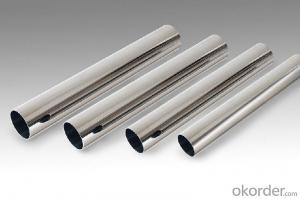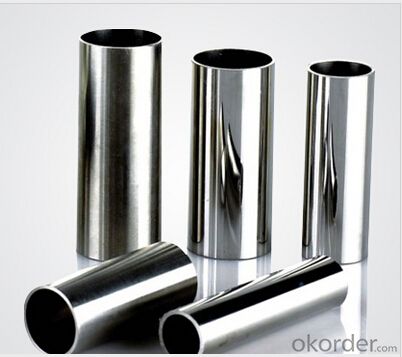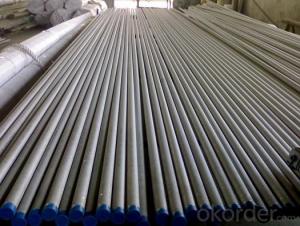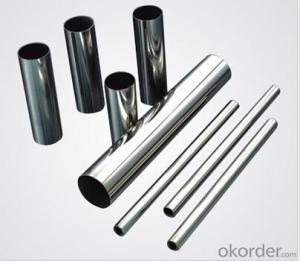Stainless Steel Sanitary Tubing ISO 2037/DIN11850
- Loading Port:
- Ningbo
- Payment Terms:
- TT OR LC
- Min Order Qty:
- 25 m.t.
- Supply Capability:
- 5000 m.t./month
OKorder Service Pledge
OKorder Financial Service
You Might Also Like
1、Structure of Stainless Steel Sanitary Tubing ISO 2037/DIN11850 Description:
Stainless steel sanitary tubing is often used in applications found in the biotech, pharma, and food/beverage industries. Sanitary tubing must be somewhat inert not to react to the chemical that pass through the tubing itself. Sanitary tubing is used in conjunction with stainless sanitary fittings.2、Main Features of the Stainless Steel Sanitary Tubing ISO 2037/DIN11850:
• High manufacturing accuracy
• High strength
• Small inertia resistance
• Good visual effect
•Reasonable price
3、Stainless Steel Sanitary Tubing ISO 2037/DIN11850 Images:
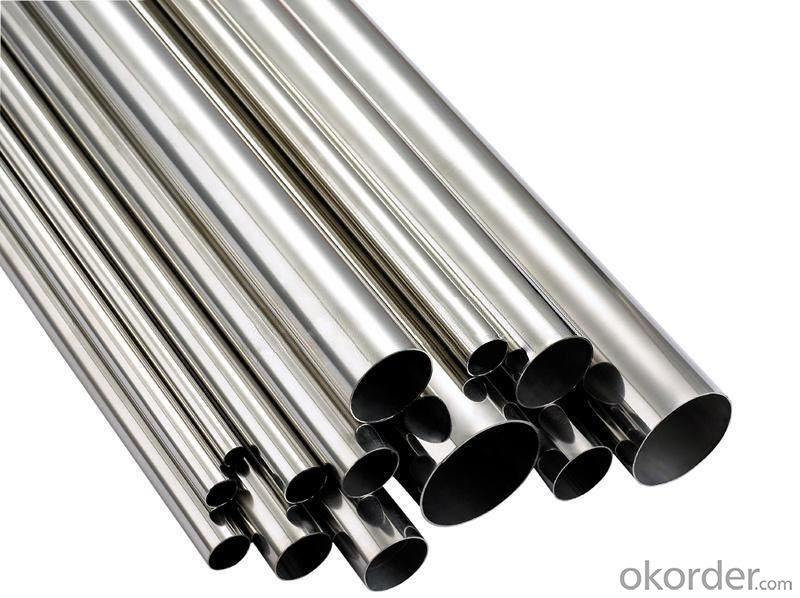

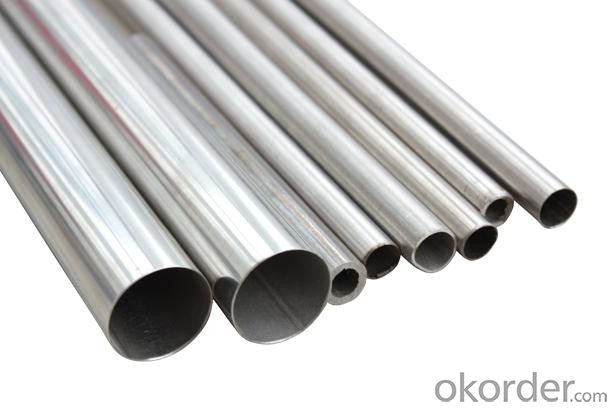
4、Stainless Steel Sanitary Tubing ISO 2037/DIN11850 Specification:
Size:
| Outside diameter | Thickness(mm) | |||||
| (inch) | (mm) | 1 | 1.5 | 2 | 2.5 | 3 |
| 3/4′ | 19.1 | |||||
| 7/8′ | 22.2 | |||||
| 1′ | 25.4 | |||||
| 1-1/8′ | 28.6 | |||||
| 1-1/4′ | 31.8 | |||||
| 1-1/2′ | 38.1 | |||||
| 40 | ||||||
| 45 | ||||||
| 2 | 50.8 | |||||
| 52 | ||||||
| 2-1/4′ | 57.15 | |||||
| 2-1/8′ | 60.3 | |||||
| 2-1/2′ | 63.5 | |||||
| 70 | ||||||
| 3 | 76.2 | |||||
| 85 | ||||||
| 3-1/2′ | 88.9 | |||||
| 4′ | 101.6 | |||||
| 4-1/8′ | 104.78 | |||||
| 4-1/4′ | 107.95 | |||||
| 4-1/2′ | 114.3 | |||||
| 5-1/4′ | 133.35 | |||||
| 6-1/4′ | 158.75 | |||||
| 8-5/8′ | 219.08 | |||||
Tolerances on dimensions table:
| Outside diameter | Thickness | Length | |
| <25.40mm | ±0.13mm | ±10.00% | OD<101.60mm +3.20mm -0mm OD≥101.60mm +4.80 -0mm |
| ≥25.40mm~50.80mm | ±0.20mm | ||
| ≥50.80mm~76.20mm | ±0.25mm | ||
| ≥76.20mm~101.60mm | ±0.38mm | ||
| ≥101.60mm~139.70mm | ±0.38mm | ||
| ≥139.70mm~203.20mm | ±0.76mm | ||
| ≥203.20mm~304.80mm | ±1.27mm | ||
5、FAQ of Stainless Steel Sanitary Tubing ISO 2037/DIN11850:
①How is the quality of your products?
Our products are manufactured strictly according to national and internaional standard, and we take a test on every pipe before delivered out. If you want see our quality certifications and all kinds of testing report, please just ask us for it.
Guaranteed: If products’ quality don’t accord to discription as we give or the promise before you place order, we promise 100% refund.
②How about price?
Yes, we are factory and be able to give you lowest price below market one, and we have a policy that “ for saving time and absolutely honest business attitude, we quote as lowest as possible for any customer, and discount can be given according to quantity”,if you like bargain and factory price is not low enough as you think, just don’t waste your time.Please trust the quotation we would give you, it is professional one.
③Why should you chose us?
Chose happens because of quality, then price, We can give you both.Additionally, we can also offer professional products inquiry, products knowledge train(for agents), smooth goods delivery, exellent customer solution proposals.Our service formula: good quality+good price+good service=customer’s trust
SGS test is available, customer inspection before shipping is welcome, third party inspection is no problem.
Any question, pls feel free to contact us !
- Q: Are stainless steel pipes suitable for desalination plants?
- Yes, stainless steel pipes are suitable for desalination plants. Desalination plants are facilities designed to remove salt and other impurities from seawater or brackish water to produce freshwater. These plants require pipes that can withstand the harsh conditions of the desalination process, which involves high pressure, high temperatures, and exposure to corrosive substances. Stainless steel pipes are an excellent choice for desalination plants due to their inherent corrosion resistance properties. Stainless steel contains a minimum of 10.5% chromium, which forms a thin protective oxide layer on the surface of the material, preventing corrosion and ensuring longevity. This oxide layer acts as a barrier, protecting the steel from the corrosive effects of seawater, brine, and other chemicals used in the desalination process. Furthermore, stainless steel pipes are highly durable and can withstand extreme temperatures and pressures without compromising their structural integrity. They are also resistant to scaling and fouling, which are common issues in desalination plants due to the high concentration of minerals and salts in the water. In addition to their corrosion resistance and durability, stainless steel pipes are also hygienic and easy to clean, making them suitable for desalination plants that require regular maintenance and cleaning to ensure efficient and reliable operation. Overall, stainless steel pipes are an ideal choice for desalination plants due to their corrosion resistance, durability, and ease of maintenance. They can effectively handle the demanding conditions of the desalination process, ensuring the production of high-quality freshwater.
- Q: How thick is the 3 stainless steel tube?
- Refers to the stainless steel tube with a wall thickness of 3 mm.
- Q: Can stainless steel pipes be used for gas applications?
- Yes, stainless steel pipes can be used for gas applications. Stainless steel is highly resistant to corrosion and can withstand high temperatures, making it a suitable material for transporting gases. Additionally, stainless steel pipes have excellent strength and durability, ensuring the safety and reliability of the gas system. They are commonly used in industrial, commercial, and residential applications where gas is being transported. However, it is essential to ensure that the stainless steel pipes being used meet the specific requirements and standards for gas applications to ensure proper installation and performance.
- Q: What is the difference between Schedule and Nominal Pipe Sizes for stainless steel pipes?
- Schedule and Nominal Pipe Sizes are both used to describe stainless steel pipes, but they refer to different aspects of the pipe. Schedule refers to the wall thickness of the pipe and is denoted by a number. It is a standardized system used to categorize pipes based on their wall thickness. The schedule number indicates the thickness of the pipe in relation to its diameter. For example, a Schedule 40 pipe has a thicker wall than a Schedule 10 pipe of the same diameter. The higher the schedule number, the thicker the wall. On the other hand, Nominal Pipe Size (NPS) refers to the approximate inner diameter of the pipe and is expressed in inches. NPS is a non-dimensional size designation that does not correspond directly to the actual dimensions of the pipe. It is used as a convenient reference for pipe identification and is often used in conjunction with the schedule number to specify a particular pipe. In summary, the main difference between Schedule and Nominal Pipe Sizes for stainless steel pipes lies in what they describe. Schedule indicates the wall thickness, while Nominal Pipe Size refers to the approximate inner diameter of the pipe. Both are important factors to consider when selecting the appropriate stainless steel pipe for a specific application.
- Q: Are stainless steel pipes resistant to scaling and oxidation?
- Stainless steel pipes possess exceptional resistance against scaling and oxidation due to the presence of a protective chromium oxide layer on their surface. This layer acts as a barrier, shielding the underlying metal from oxygen and other elements that can lead to scaling and oxidation. Consequently, stainless steel pipes are capable of enduring high temperatures, corrosive surroundings, and frequent contact with water without any deterioration or rusting. Hence, they are an ideal option for numerous applications in industries like construction, chemical, and food processing, where the ability to resist scaling and oxidation is paramount.
- Q: Can stainless steel pipes be used for solar thermal systems?
- Yes, stainless steel pipes can be used for solar thermal systems. Stainless steel is highly corrosion resistant and can withstand the high temperatures and pressures typically found in solar thermal systems. It is a reliable and durable choice for transporting the heat transfer fluid in these systems.
- Q: Can stainless steel pipes be used for chemical drainage?
- Yes, stainless steel pipes can be used for chemical drainage. Stainless steel is highly resistant to corrosion and can withstand exposure to a wide range of chemicals, making it a suitable choice for chemical drainage systems.
- Q: What is the weight of stainless steel pipes?
- The weight of stainless steel pipes may differ based on factors such as their length, diameter, and wall thickness. Due to its high density, stainless steel pipes generally have a greater weight in comparison to pipes manufactured from alternative materials. Typically, the weight of stainless steel pipes is quantified in kilograms or pounds per meter or per foot. It is crucial to acknowledge that the weight can vary depending on the particular grade of stainless steel employed during the pipe fabrication process.
- Q: Can stainless steel pipes be used in pharmaceutical industries?
- Indeed, stainless steel pipes find utility within pharmaceutical industries. The pharmaceutical sector favors stainless steel as a material of choice due to its superb resistance against corrosion, endurance, and cleanliness. It possesses non-reactive and non-contaminating properties, rendering it suitable for the conveyance and storage of diverse pharmaceutical compounds, such as acids, bases, solvents, and other chemicals. Furthermore, stainless steel pipes exhibit resilience against elevated temperatures and pressures, qualifying them for deployment in numerous pharmaceutical manufacturing procedures. Moreover, stainless steel is effortlessly cleanable and sanitizable, guaranteeing the upholding of superior hygiene standards within the pharmaceutical industry.
- Q: What is the difference between nominal size and actual size in stainless steel pipes?
- The distinction between nominal size and actual size in stainless steel pipes lies in their measurement and labeling methods. Nominal size refers to the assigned name of a pipe based on its approximate dimensions, typically in inches or millimeters. This name serves the purpose of easy identification and standardization. In contrast, actual size refers to the precise measurements of the pipe, including its outer diameter (OD) and wall thickness. These measurements are usually expressed in fractions of an inch or millimeters. The accurate dimensions are vital for determining the pipe's compatibility with fittings, valves, and other components, as well as for calculating flow rates and pressure ratings. It is important to acknowledge that the nominal size of a stainless steel pipe may not always align with its actual size. This discrepancy arises from historical factors and manufacturing practices. In certain instances, the nominal size may be slightly larger or smaller than the actual size to account for variations in wall thickness or to conform to industry standards. Therefore, when selecting stainless steel pipes, it is crucial to consider both the nominal size and the actual size to ensure proper fit and functionality. Referring to the manufacturer's specifications or seeking professional advice can aid in determining the appropriate pipe size for a specific application.
Send your message to us
Stainless Steel Sanitary Tubing ISO 2037/DIN11850
- Loading Port:
- Ningbo
- Payment Terms:
- TT OR LC
- Min Order Qty:
- 25 m.t.
- Supply Capability:
- 5000 m.t./month
OKorder Service Pledge
OKorder Financial Service
Similar products
Hot products
Hot Searches
Related keywords

